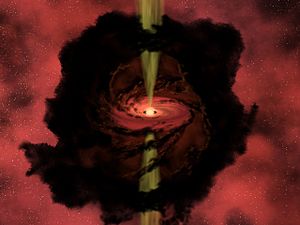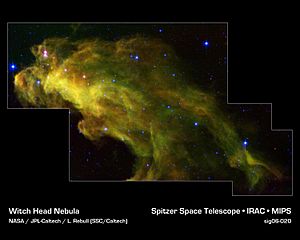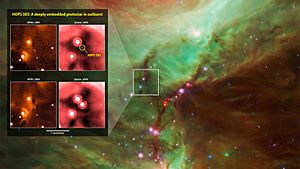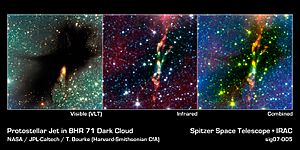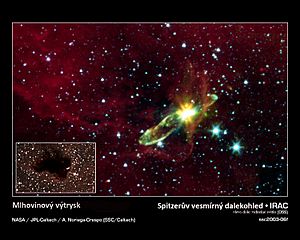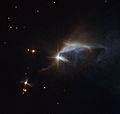Protostar facts for kids
A protostar is like a baby star, still growing up! It's the very first stage in a star's life. Imagine a huge, cold, dark cloud of gas and dust in space. This cloud slowly starts to pull itself together. As it gathers more and more material, it gets ready to become a real star.
Protostars are much cooler than the bright stars we see in the sky. For a star like our Sun, a special type of "fusion" (where atoms join together) happens in the protostar stage. This is called deuterium fusion. The main fusion that makes stars shine for billions of years starts much later. The idea of protostars as we know them today was first suggested by a scientist named Chushiro Hayashi in 1966.
How Do Protostars Form?
Space might seem empty, but it's actually filled with tiny bits of gas and dust. This is called the interstellar medium. In some places, this gas and dust gathers into big clouds. These clouds are called molecular clouds, and they are where new stars are born!
Molecular clouds are very cold and dense compared to other parts of space. Because they are so dense, gravity can start to pull the gas and dust together. This pulling action is called gravitational collapse. It's the first step in making a star.
Sometimes, something can give these gas clouds a push to start forming stars. This is called "triggered star formation." For example, a powerful shock wave from an exploding star nearby can squeeze the gas cloud. Or, if the cloud passes through a part of a spiral galaxie where gravity is stronger, it can also get compressed. This compression helps gravity take over and start the collapse.
When gravity starts pulling the gases into a ball, a protostar begins to form. This process of gathering more material is called accretion.
As a protostar shrinks, it starts to spin faster. Think of an ice skater pulling their arms in to spin faster. Because it's spinning, it's easier for gas and dust to fall onto the top and bottom (the poles) of the protostar. Material trying to fall onto the middle (the equator) gets "held back" by the spin. This causes the gas and dust to flatten out into a swirling disk around the protostar's middle. These "circumstellar disks" are super important because they are where planets can form later!
As a protostar spins, it also creates a strong magnetic field. This field can shoot out a powerful flow of particles into space, called a protostellar wind. Many protostars also blast out high-speed jets of gas. These jets usually shoot out from the top and bottom of the protostar, along its spin axis. Eventually, these winds and jets help clear away the extra gas around the protostar, allowing us to see the young star and its disk.
When the protostar collapses, the gas particles inside it crash into each other. This makes the protostar heat up. The energy from the gas falling inwards turns into heat. The warm gas then gives off energy as radiation. This radiation travels through the dust around the protostar. The dust absorbs this energy and then sends it back out as infrared light, which is a type of light we can't see, but feel as heat.
A protostar is not as hot as a fully formed star. At its center, the main type of hydrogen isn't fusing yet. However, a small amount of deuterium (a heavier type of hydrogen) can fuse with regular hydrogen. This fusion creates helium-3 and helps to heat up the protostar. This heat also helps to decide how big the youngest pre-main-sequence stars will be.
A protostar officially becomes a main sequence star (like our Sun) when its core gets hot enough for hydrogen fusion to start working well. This usually happens when the center reaches about 10 million degrees Kelvin.
It takes a long time for a protostar to become a full star. For a star like our Sun, it takes about 50 million years. Very big stars form much faster, sometimes in just a million years. Smaller stars can take over a hundred million years to form.
If a protostar doesn't gather enough mass (less than 0.08 times the mass of our Sun), it will never get hot enough for hydrogen fusion. In these cases, the protostar becomes a brown dwarf, which is like a failed star.
Images for kids
See also
 In Spanish: Protoestrella para niños
In Spanish: Protoestrella para niños


